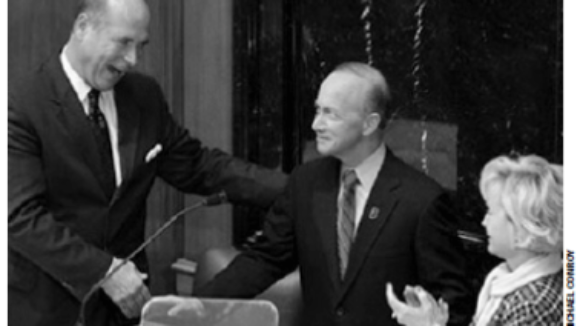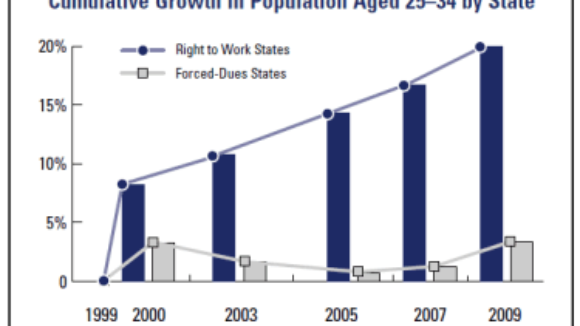Attorney Generals Demand NLRB Withdraw Anti-Right to Work Complaint
Eight Attorney Generals have written a letter to the General Counsel of the NLRB demanding he withdraw his complaint against…

Eight Attorney Generals have written a letter to the General Counsel of the NLRB demanding he withdraw his complaint against…

(Source: March 2011 NRTWC Newsletter) In Contrast, Maine Governor Stands Up For His Avowed Principles Eight years ago, Indiana citizens who were determined to free themselves and their fellow Hoosiers from the shackles of compulsory unionism launched what they knew from the beginning would be a sustained, and often difficult, effort to pass a state Right to Work law. Ever since then, the organization these citizens put into high-gear in 2003, the Indiana Right to Work Committee, has mobilized an ever-loudening drumbeat of support for employee freedom. Over the course of the ongoing campaign, the Indianapolis-based Right to Work group has benefited from the counsel and experience of the National Right to Work Committee. And National Committee members and supporters who live in the Hoosier State, roughly 119,000 strong and growing in number year after year, have been the bulwark of the Indiana Right to Work campaign. Stubborn Opposition to Right To Work Has Ended Long Political Careers in Indiana In the 2004, 2006, 2008 and 2010 state election cycles, pro-Right to Work Hoosiers sent thousands upon thousands of postcards, letters, and e-mail messages to their legislative candidates urging them to oppose forced unionism. Right to Work activists also reinforced the point with phone calls and personal visits. Since the Indiana Committee emerged as a major statewide citizens lobby, many politicians who once rode the fence have decided to take a stand in favor of Right to Work. Other politicians who stubbornly continued to carry water for, or at least appease, Big Labor have gone down to defeat. For example, in early 2005, then-Senate President Pro Tem Robert Garton (R-Columbus) told National Right to Work Committee President Mark Mix that Right to Work legislation wouldn't get a floor vote in his chamber as long as he held his leadership position. In 2006, Mr. Garton, a 36-year incumbent and the longest serving Senate pro tem in American history, was defeated by primary challenger Greg Walker, an underfunded political novice. A critical asset Mr. Walker did have going for him was his 100% support for Right to Work. That same year, 26-year state Rep. Mary Kay Budak (R-LaPorte) was ousted in a primary upset by pro-Right to Work challenger Tom Dermody. A few months earlier, Ms. Budak had been one of the minority of House Republicans who voted with Big Labor to defeat an amendment that would have made Indiana a Right to Work state.

The BNA news service reports that the attorneys general of South Carolina, Alabama, Arizona, Florida, Georgia, Nebraska, Oklahoma, Texas, and Virginia are challenging the NLRB’s overreach in its attempt to circumvent state Right to Work laws: The attorneys general…
Right to Work Oklahoma City, OK will be home to a new Boeing facility according to the Tacoma News Tribune: The company will use the 320,000-square-foot structure near Tinker Air Force Base as home to its B-1 bomber modification program and…

(Source: March 2011 NRTWC Newsletter) Millions Have 'Voted With Their Feet' For Better Opportunities For a combination of reasons, nationwide the number of young adults aged 25-34 is growing far more slowly than is the number of Americans aged 55 and older. In 1999, according to the U.S. Census Bureau, there were 37.94 million people aged 25-34 living in the U.S. By 2009, there were 41.57 million people nationwide in that age bracket. That's a 9.6% increase. Over the same decade, the number of Americans aged 55 and older soared from 57.93 million to 74.36 million, a whopping 28.4% increase! The nationwide decline in young employees' population share, relative to that of Americans nearing or in their retirement years, is obviously an impediment to economic growth. Eleven Non-Right to Work States Suffered Young-Adult Population Declines
The New Hampshire Right to Work Bill is close to becoming law and bringing with it the end of compulsory unionism in the Granite State. Senator Ray White explains his support…
The New Hampshire Right to Work Bill is close to becoming law and bringing with it the end of compulsory unionism in the Granite State. Senator Ray White explains his support…
To borrow from President Obama’s own words regarding WI Gov. Scott Walker, his NLRB has committed an “assault on workers” at the Boeing factory in South Carolina. The National Right to Work Legal Defense Foundation is offering help, see press release…
To borrow from President Obama’s own words regarding WI Gov. Scott Walker, his NLRB has committed an “assault on workers” at the Boeing factory in South Carolina. The National Right to Work Legal Defense Foundation is offering help, see press release…